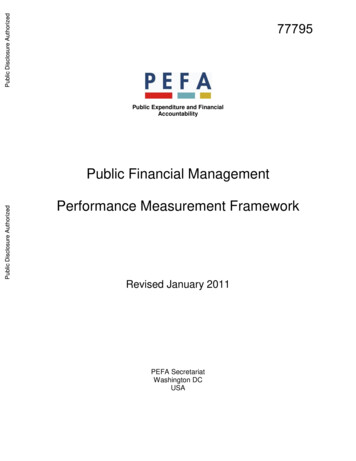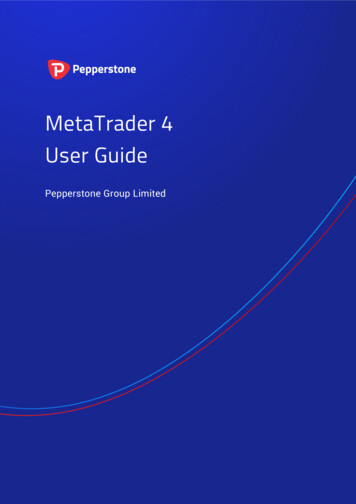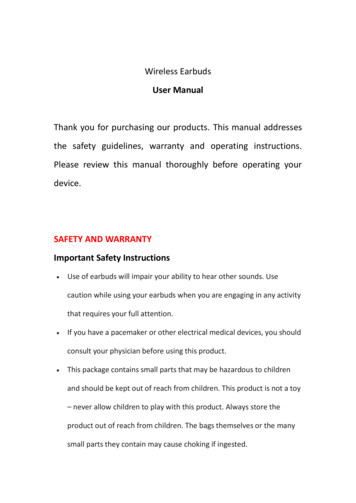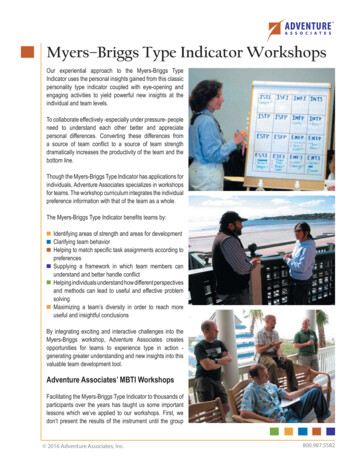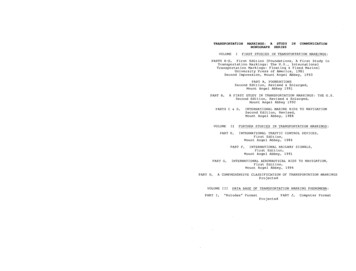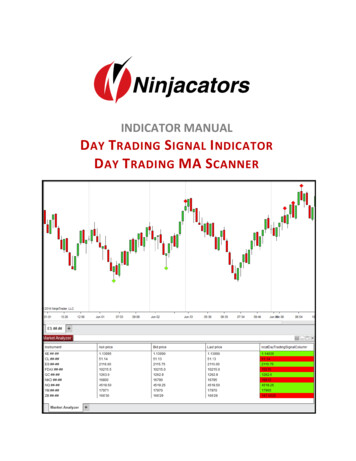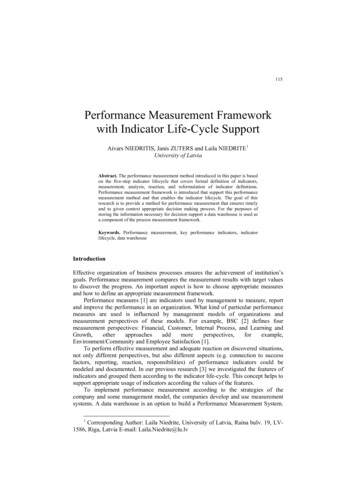
Transcription
115Performance Measurement Frameworkwith Indicator Life-Cycle SupportAivars NIEDRITIS, Janis ZUTERS and Laila NIEDRITE 1University of LatviaAbstract. The performance measurement method introduced in this paper is basedon the five-step indicator lifecycle that covers formal definition of indicators,measurement, analysis, reaction, and reformulation of indicator definitions.Performance measurement framework is introduced that support this performancemeasurement method and that enables the indicator lifecycle. The goal of thisresearch is to provide a method for performance measurement that ensures timelyand to given context appropriate decision making process. For the purposes ofstoring the information necessary for decision support a data warehouse is used asa component of the process measurement framework.Keywords. Performance measurement, key performance indicators, indicatorlifecycle, data warehouseIntroductionEffective organization of business processes ensures the achievement of institution’sgoals. Performance measurement compares the measurement results with target valuesto discover the progress. An important aspect is how to choose appropriate measuresand how to define an appropriate measurement framework.Performance measures [1] are indicators used by management to measure, reportand improve the performance in an organization. What kind of particular performancemeasures are used is influenced by management models of organizations andmeasurement perspectives of these models. For example, BSC [2] defines fourmeasurement perspectives: Financial, Customer, Internal Process, and Learning ample,Environment/Community and Employee Satisfaction [1].To perform effective measurement and adequate reaction on discovered situations,not only different perspectives, but also different aspects (e.g. connection to successfactors, reporting, reaction, responsibilities) of performance indicators could bemodeled and documented. In our previous research [3] we investigated the features ofindicators and grouped them according to the indicator life-cycle. This concept helps tosupport appropriate usage of indicators according the values of the features.To implement performance measurement according to the strategies of thecompany and some management model, the companies develop and use measurementsystems. A data warehouse is an option to build a Performance Measurement System.1Corresponding Author: Laila Niedrite, University of Latvia, Raina bulv. 19, LV1586, Riga, Latvia E-mail: Laila.Niedrite@lu.lv
116A. Niedritis et al. / Performance Measurement Framework with Indicator Life-Cycle SupportAn advantage of using a data warehouse for the implementation of a performancemeasurement system is the possibility to use existing infrastructure of the company’sdata warehouse.Traditionally data warehouses store customer and financial indicators of thecompanies, but other perspectives are typically not covered. Some attempts to integratethe perspective of internal business processes into a data warehouse have been made in[4, 5, 6].We do not try to incorporate another perspective of measurements into the datawarehouse. We propose to use the data warehouse as an integral part of a performancemeasurement system, which can store indicators of different perspectives and can beused according to proposed measurement framework.The measurement framework describes different measurement aspects to bringorder within this important undertaking of the organization. Thereby, the quality ofmeasurement is improved, for example, by means of performing the analysis of rightindicators in right time and undertaking the right actions as a result.The usage of an existing data warehouse gives additional advantage to theperformance measurement. The analysis of indicator values can be performed usingexisting OLAP tools, reports and dashboards.We start with related work described in section 1. Section 2 explains the concept ofindicators life-cycle that forms the basis for proposed measurement framework. Insection 3 the reporting tool and its metadata is described that is one of the ready-madedata warehousing components used within the measurement framework. Thearchitecture of performance measurement system is given in section 4. In section 5 theconclusions are given.1. Related WorkPerformance measurement systems implemented by means of a data warehouse aregiven in several works. The existing approaches concentrate mostly on how to build anappropriate dimensional model of the data warehouse according the process perspectiveof measures to be stored.The Process Data Warehouse [5] stores histories of engineering processes andproducts for experience reuse. The Performance Management System (PMS) [6] storesfinancial and non-financial data centrally. The PMS contains values of measurementsas well as supplementary information about company structure, business processes,goals and performance measures. Besides traditional data warehousing perspectives theprocess perspective is also analyzed. In [4], the authors propose a CorporatePerformance Measurement System (CPMS), where process performance data isintegrated with institution’s data warehouse. Log files of a workflow system are usedas data sources. The model of CPMS is developed as a part of an existing datawarehouse model of the company.A category of data warehouses for performance measurement can be distinguished,where the business process execution data is stored. The systems already mentioneduse workflow data as one of data sources, but workflow data warehouse [7] representsthe concept of Data Warehouse of Processes. The authors of Workflow DataWarehouse [7] argue why and when data warehouse can become an appropriatesolution for storing and analyzing log files of process execution.
A. Niedritis et al. / Performance Measurement Framework with Indicator Life-Cycle Support117Methodologies how the performance should be evaluated also are a subject ofresearch. For example, methodology [8], based on dynamic process performanceevaluation, proposes measurement models for analysis of different process flows inorder to control the quality of process execution. Activity flow, information flow,resource flow and others are measured using time, quality, service, cost, speed,efficiency, and importance as evaluation criteria.Our approach uses the advantages of an existing data warehouse – ETL processes,analysis tools, data storage schemas – that allow to prepare and store indicatorsaccording to the different perspectives, as well as integrates the data warehouse with aperformance measurement framework that is based on the life-cycle of indicators,which ensures the quality of the performance measurement by supplying necessaryinformation for each measurement task.2. Indicators and Their Life-CycleIn our previous research [3] we defined a lifecycle of indicators, which consists of fivesteps – indicator definition, measurement, analysis, reaction and improvement. In eachstep an indicator is characterized by a different set of properties.Indicator definition step describes the information needs of the user. In themeasurement step the indicators get the values. The analysis step represents the process,when indicators are used to make decisions. The reaction step represents theimplementation of decisions. The life-cycle ends with the evaluation of indicatordefinitions and predefined values of indicator properties during the improvement step.2.1. Groups of Indicator AspectsThe properties of indicators are grouped in aspects according to the particular step(Figure 1). The explanation of the meaning of properties can be found in [3].TYPEKRI, RIKPI, PILEVEL Organization IndividualTIME Orientation(Past, Current ,Future)Definition aspectsof indicatorsIndicatorREPORTED TO Management Responsible for processesTIME Reporting timeIndicatorANALYSTPROCESS(for PI andKPI)DATA SOURCE Existing To be gatheredTIME FrequencyPERSPECTIVE Customer Finance Internal Processes Learning and Growth Environment /Community Employee satisfactionIndicatorMeasurement aspectsof indicatorsSUCCESS FACTORS Success factor Critical success factorMODEL Indicator dependencies Indicator hierarchy Base / derived measuresMETHOD Automatically/calculated Manual/surveysVALUES OF ASPECTS To be changedAnalysis aspects ofindicatorsPROCESS Rebuild ImprovedANALYSIS MODEL Analytical functions RepresentationACTIONS To be performedIndicatorTIME Reaction timeReaction aspects ofindicatorsIndicatorTARGET VALUE Decision criteriaDEFINITION To be adjusted Accepted/RejectedImprovement aspects of indicatorsFigure 1. Five groups of indicator aspects [3]RESPONSIBLE FOR Reaction
118A. Niedritis et al. / Performance Measurement Framework with Indicator Life-Cycle SupportOne of the questions raised by the proposed measurement framework withindicators as the central element of interest was how the indicators should beformalized to bring the maximum of clarity into the measurement process – what, whyand how is measured. Our previous research [3] is focused on the formal definition ofindicators. The formalization method of sentences that expresses the indicators wasproposed.2.2. Formal Model for Indicator DefinitionOn one hand, indicators are the focus of data analysis in the measurement process. Onthe other hand, data warehousing models are built to represent the information needsfor data analysis. Therefore we could talk about indicators as an informationrequirement for a data warehouse system.The type of an information system to be developed has some impact on a way offormulating sentences that express requirements. We assumed that requirements fordata warehouses and information requirements particularly have a similar structure orpattern. We based the proposed model on the structure evaluation of the sentences thatformulate performance indicators taken from the performance measures database [1].All indicators have common structure, for that reason it is possible to determine apattern for re-writing business requirements formally. The requirement formalizationmay be represented as a metamodel. The detailed description of the metamodel and thealgorithm how the sentences expressing the indicators are reformulated according tothe given metamodel can be found in [3].3. Reporting Tool and its MetamodelOne important and integral part of our process measurement framework is a reportingtool developed at the University of Latvia. This reporting tool is developed as the partof the data warehouse framework [9]. The reporting tool is based on metadata and inthe latest version it has five metadata layers (Figure 2) that describe different aspects ofdefining and storage of a data warehouse schemata as well as defining and operatingreports defined on these schemata.Semantic, Logical and Physical metadata describe the data warehouse schemata indifferent levels of abstraction, starting from the business understanding of the schemaelements, describing it by means of OLAP concepts at logical level and ending with thephysical storage of the data warehouse tables. OLAP Preferences metadata isintroduced to describe the user preferences on reports’ structure and data and is usedfor OLAP personalization purposes. Reporting metadata contains definitions of reportson data warehouse schemata.Semantic MetadataOLAPPreferencesMetadataLogical MetadataPhysical MetadataFigure 2. Metadata connections [10]ReportingMetadata
A. Niedritis et al. / Performance Measurement Framework with Indicator Life-Cycle Support119Metadata levels are interconnected by associations between particular classes ofmetadata. In the context of this research, the Logical and Reporting metadata are ofparticular interest; so both the levels as well as the connections between them will bedescribed in more detail here. Detailed description of the rest of the metadata levels canbe found in our previous research [11, 12].3.1. Logical Level MetadataThe logical level metadata describes the data warehouse schema from themultidimensional viewpoint (Figure 3) and mostly is based on the OLAP package ofCommon Warehouse Metamodel (CWM) [13]. Therefore it contains the core conceptsof OLAP – dimensions and fact tables (cubes in CWM).Fact tables contain measures, but dimensions consist of attributes and hierarchiesbuilt from hierarchy levels. Fact tables and dimensions have FactTableDimensionassociation. Only dimensions and fact tables having FactTableDimension associationscan be used simultaneously in one report. More about connections with reportingmetadata is given in section 3.3.The standard OLAP package of CWM is extended by the classAcceptableAggregation that allows only meaningful definitions of aggregate functions(e.g. SUM, AVG) for each measure and dimension. This metadata is used to ensurecorrect queries by the reporting me-Description0.**1Hierarchy-Name-{ordered} -DescriptionFigure 3. Logical level metadata [11]3.2. Reporting Level MetadataReporting metadata describes the structure of reports (Figure 4). In the meaning of thismodel, reports are worksheets. Worksheets contain data items defined by calculations.Calculations in their turn specify formulas containing parameters and table columnsthat correspond to schema elements of the underlying data warehouse. Reports also arebased on joins between tables and may have user-defined conditions.Reports in the tool are created by choosing desired elements of a data warehouseschema and defining conditions, parameters etc. Only measures and attributesbelonging to one schema could be included in the definition of one report.
120A. Niedritis et al. / Performance Measurement Framework with Indicator Life-Cycle me-Type-Title*-compares m m Physical)Measure-(from Logical)1Figure 4. Reporting metadata [14, 12]3.3. Connections between Logical and Reporting MetadataThe models of logical and reporting metadata are interrelated. Report items are definedby formulas from calculation parts. If a calculation part corresponds to a particulardimension attribute or measure, then this schema element from Logical metadata isconnected to the class CalculationPart by the association ‘corresponds’ in thereporting metadata.4. Construction of Performance Measurement FrameworkWe propose an approach of building Performance measurement systems bysubstantially exploiting existing data warehouse technologies.The proposed Performance measurement framework is grounded on the followingprinciples of design and operation: processing of indicator information is performed in conformance with the lifecycle of indicators and formal indicator metamodel, defined in [3]; measurement data are obtained through an ETL process and stored in a datawarehouse; indicator analysis aspect is provided by using a ready-made data warehousereporting tool extensively both for obtaining actual value from measurementdata and providing users with detailed reports.4.1. Architecture of Performance Measurement SystemThe kernel of the performance measurement framework (Figure 5) consists ofperformance management component and the indicator life-cycle support database, aswell as the dashboard module.Indicator life-cycle support database (detailed information is given in the nextsection) stores links to the formal definitions of indicators from the Indicator formaldefinition database, which is built according to the formal model for indicatordefinition described earlier in section 2.2. These indicator definitions are collected andformalized during the requirements gathering process for obtaining the precise andappropriate indicators for process measurement, as well as for documenting theinformation requirements of a data warehouse.
A. Niedritis et al. / Performance Measurement Framework with Indicator Life-Cycle Support121Data sourcesIndicator formaldefinition databaseIndicator editorETLData warehouse layerIndicator life-cyclesupport databaseETL metadataformeasurementsDatawarehouseand reportingMeasurementdataIndicator layerDashboard modulePerformance managementcomponentReporting toolFigure 5. Data flow diagram of the performance measurement frameworkIndicator editor is an administrative tool and is meant for two purposes: (1) toestablish the links between the Indicator layer of the system and the Indicator formaldefinition database and (2) to configure the Indicator measurement (or ETL) metadata.The measurement process, during which indicators get their values, is performedthrough the ETL processes, which use corresponding ETL metadata for measurements.The ETL component is an external part of the performance measurement framework. Inthe context of this research we assume that a set of procedures is defined forperforming the data warehouse data renewal according to the values of ETL metadatafor measurements (e.g. according to the planned timing schedule). During the ETLprocesses data from external Data sources are processed and loaded into the datawarehouse that represents in our framework the Measurement data.The remaining part of the data warehouse layer of the proposed framework is theData warehouse and reporting metadata component that is developed according thepreviously described metadata layers in sections 2.1 and 2.2 that describe respectivelythe logical level of data warehouse schema and the reporting metadata.Performance management component is the main part of the framework that isprovided to coordinate the monitoring of business processes by analyzing themeasurement results of indicators. Component is based on descriptions of differentproperties of indicators that are stored in the Indicator life-cycle support database andthat allow the user to analyze the indicator values in the most appropriate way bymeans of two other components of the framework – Dashboard module and theReporting tool.The Dashboard module visualizes the most important values of indicatorscomparing them to the stored target values of indicators. The reporting tool providesmore detailed information to the user by calling predefined reports linked to particularindicator definition. An existing reporting tool is used, which is built according to the
122A. Niedritis et al. / Performance Measurement Framework with Indicator Life-Cycle Supportprevious mentioned reporting metadata (more information about this tool can be foundin [14, 12].4.2. Indicator Life-Cycle Support DatabaseIndicator life-cycle support database spins around the ‘Indicator life-cycle supportmetadata’ (Figure 6), which define the behavior of the framework. These metadata areused by Performance management component designed to coordinate the workflow ofthe indicator life-cycle.ETL metadata for emaLink to ETL DW metadataIndicator formaldefinition torPerspective {cust,fin,.}SuccessImpactLevel {org,indiv}TimeOrientationIndicatorType nitionDecisionOperator { , , ype formIndicator life-cycle supportmetadata1.nIndicator life-cycle supportexecution s RequiredReactionTimeReactionTimeDashboard modulePerformance management componentReporting toolFigure 6. Indicator life-cycle support database and the contextAs the duty of performing measurements is fully assigned to the data warehouse,ETL metadata are prepared and stored separately from Indicator life-cycle supportdatabase. Actually, this is one of the key points of the framework to fully connect datawarehouse for such functionality.Workflow status is stored in the ‘Indicator life-cycle support execution data’ and isaccessible directly by users via Dashboard module. Workflow status is controlled bothby Performance management component and by Dashboard module. It incorporatesinformation about notifications by the system sent to users and the reaction of users tothem.
A. Niedritis et al. / Performance Measurement Framework with Indicator Life-Cycle Support1234.3. Indicator Life-Cycle Steps in Performance Measurement FrameworkAccording to the indicator life-cycle definition in section 2, Performance measurementframework should support all five steps of the life-cycle. This section is to describe theproposed framework according to the life-cycle steps.Indicator life-cyclesupport metadataset metadataETLmetadataDatasourcesETLData rementReporting ontrolIndicator workflowIndicator tframeworkLEGENDMapping between Indicator life-cycle and Performancemeasurement framework as described in Table 1Indicating the method as part of the particular frameworkcomponentWorkflow of processing indicator dataFigure 7. Indicator life-cycle support implemented by the Performance measurement frameworkFigure 7 shows the connections between each step and the workflow performed bythe framework components and different data. The workflow of processing indicatordata is organized in the following steps:1. Measurement step is performed by an ETL process of the data warehouse (seesection 4.4).2. In analysis step measurement data are processed according to indicator lifecycle support metadata by the Performance management component (see thealgorithm in Figure 8). Reporting tool is used here to obtain the actual value ofthe indicator. During this step, a record is added to the indicator life-cycleexecution data; thus, the information about the performed measurements ofindicators in form of a notification becomes visible to appropriate users in aspecial dashboard.
124A. Niedritis et al. / Performance Measurement Framework with Indicator Life-Cycle Support3. User’s reaction is obtained from the Dashboard module (Figure 9) and can beof two types: A request for the detailed notification. Reporting tool is used here toobtain a report that describes the actual measurement in detail; Reaction. If the description of an indicator provides for a response to thenotification, user is required to assert this in time and in a special way.4. In control step Performance management component checks whether usershave responded to the notifications, if such reactions were appointed in theanalysis step (Figure 10).The above described processing of indicator data by Performance measurementframework is performed in conformance with the life-cycle of indicators.Table 1 shows mapping between the indicator life-cycle and its implementation bythe Performance measurement framework.Table 1. Mapping “Indicator life-cycle Performance measurement framework”Indicator life-cycleaspect group1. Definition2. Measurement3. Analysis4. Reaction5. ImprovementDescription of implementation by the performancemeasurement frameworkIndicator definition is described in indicator formaldefinition database, as well as Indicator life-cycle supportdatabase. Indicator definition includes preparation of themetadata required to ensure the whole process.Measurement process is fully delegated to the datawarehouse and its appropriate ETL process.Analysis is coordinated by Performance managementcomponent. Measurement data are processed and displayedto the users.A user reads and, if required, reacts to the notification.Performance management component controls the reaction.Indicator improvement technically matches indicatordefinition.Procedure analyzeBeginRepeat ForeverForeach indicator From Indicator Doanalysis : Indicator.AnalysisWait for the next report according to analysis.TimingSchemaactual value : run report according to analysis.ActualValueDefinitionIf analysis.DecisionOperator (actual value, analysis.TargetValue) True ThenForall reaction In Indicator.Reaction Doadd record to Notification WithUser : reaction.ResponsibleUserIndicator : reaction.ResponsibleUserUser : indicatorNotificationTime : current timeStatus : ‘unprocessed’Message : compute according to analysis.MessageTemplateand indicator.Definition and reaction.ActionToPerformReportConfig : set according to analysis.ReportDefinitionRequiredReactionTime : compute according to reaction.TimingSchemaReadTime : NullReactionTime : NullFigure 8. Algorithm of the analysis step in the Performance management component
A. Niedritis et al. / Performance Measurement Framework with Indicator Life-Cycle Support125Procedure reactBeginForeach userDisplay all from Notification in the dashboard Where User userForeach notification From Notification Where User user DoWait for user action DoCase user asks to show detalized information Dorun report according to notification.ReportConfig and display itCase performs an action according to report.Indicator.Reaction.ActionToPerform Donotification.ReactionTime current timeFigure 9. Algorithm of the reaction step in the Dashboard moduleProcedure controlBeginRepeat ForeverForeach notification From Notification Where ReportStatus ‘processed’ DoIf notification.Indicator.Reaction.Type ‘none’ Thennotification.Status ‘processed’ElseIf notification.ReactionTime Is Not Null Thennotification.Status ‘processed’Else If current time notification.RequiredReactionTime Thennotification.Status ‘delayed’Figure 10. Algorithm of the control step in the Performance management component4.4. Integration with Data Warehouse ComponentsETL metadata for measurements (IndicatorMeasurement class) is a part of Indicatorlife-cycle support database (Figure 6). The Indicator attribute identifies a particularattribute that is measured, whereas TimingSchema describes the time parameters ofmeasurement (e.g. frequency, exact starting time). The last attribute – ETLprocess –points to the data warehouse meatadata repository, particulary to the ETL metadata partof the repository that describes mappings between the source and data warehouseschemas. This metadata also contains calls to corresponding procedures that implementthese mappings and necessary data transformations. For the proposed measurementframework we can assume that the IndicatorMeasurement class contains the procedurecall that renews the data warehouse data schema that contains data necessary forcalculation of the given indicator.The IndicatorAnalysis class of Indicator life-cycle support database (Figure 6) andits ReportDefinition attribute is planned to be a pointer to the report definition stored inaccordance to the metamodel of the reporting tool.Reporting metadata (Figure 4) contain the Worksheet class that identifies aparticular report that can be invoked when analysis of measurement results isperformed. The report can be simple, when one particular value is retrieved to compareit with a target value, or complex, when the report is used for the detailed analysis. Thecomplexity of the report depends on the definition of the particular report.5. ConclusionsUsing data warehouses in performance measurement systems has been alreadyextensively explored. The proposed Performance measurement framework has been
126A. Niedritis et al. / Performance Measurement Framework with Indicator Life-Cycle Supportdesigned to obtain the maximum benefits from matured data warehouses technologiesin implementing indicator life-cycle support.The applied model of indicator life-cycle serves as a theoretical means of qualityassurance for the performance measurement. The use of data warehouses as integralpart of the framework covers two important aspects of ensuring the indicator life-cycle:(a) indicator measurement, and (b) part of indicator analysis (performed by Reportingmodule).The provided method for performance measurement ensures timely and to givencontext appropriate decision making process. The indicator life-cycle support databasestores metadata that define and schedule the measurement and control processes ofindicators, including timing schemas, responsibilities and actions to be performed. Theproposed framework provides the option to build performance control on the activitiesinitiated from the side of the measurement system, as soon as the system recognizes theproblem and so the need for more detailed analysis.Preliminary works of implementing the framework are already in progress, so weexpect the first experimental results in the near future.AcknowledgmentsThis work has been supported by European Social Fund (ESF) projectNo. s[1]D. Parmenter, Key Performance Indicators: Developing, Implementing, and Using Winning KPIs.Second ed. Jon Wiley & Sons, 2010.[2] R. S. Kaplan and D. P. Norton, The Balanced Scorecard. Harvard Business School Press, 1996.[3] A. Niedritis, L. Niedrite, and N. Kozmina, Performance measurement framework with formal indicatordefinitions. In: J. Grabis, M. Kirikova, editors, Perspectives in Business Informatics Research, LectureNotes in Business Information Processing 90 (2011), Springer, Berlin, 44-58.[4] B. List and K. Machaczek, Towards a corporate performance measurement system. I
indicators and grouped them according to the indicator life-cycle. This concept helps to support appropriate usage of indicators according the values of the features. To implement performance measurement according to the strategies of the company and some management model, the companies develop and use measurement systems.


